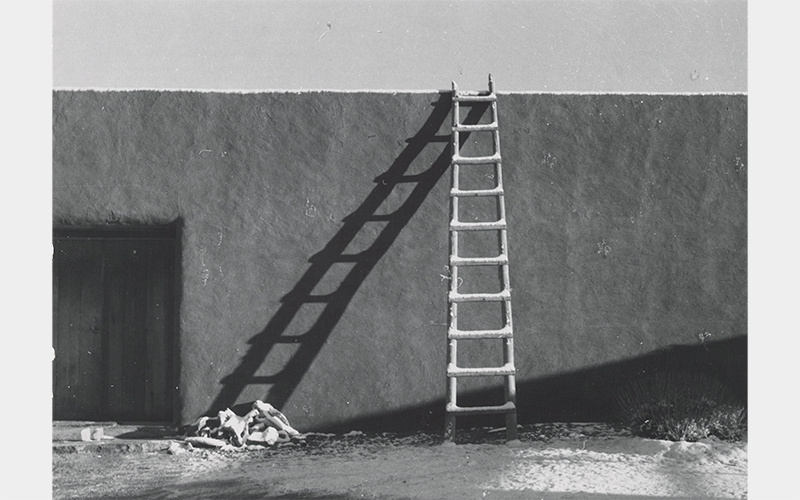
Georgia O’Keeffe (American, 1887–1986), Ladder against Studio Wall in Snow, 1959–60, gelatin silver print, Georgia O’Keeffe Museum, Santa Fe, 2006.6.1409
11 3/4 × 14 3/4 × 1 3/8 in. (29.8 × 37.5 × 3.5 cm)
Verbal Description
Hello, my name is Nathaniel Stein, the museum’s curator of photography and curator overseeing the Cincinnati presentation of this exhibition. I will be reading the verbal description of Ladder against Studio Wall in Snow in Georgia O’Keeffe, Photographer.
The photograph, Ladder against a Studio Wall in Snow from 1959-1960, is a gelatin silver print. It was taken by Georgia O’Keeffe, an American artist who lived from 1887 to 1986. It is in the collection of the Georgia O’Keeffe Museum in Santa Fe. The acquisition number is 2006.6.1409
Ladder against a Studio Wall in Snow is a landscape-oriented black-and-white photograph measuring 11 and three-quarter inches by 14 and three-quarter inches. In the image, a snow-covered wooden ladder rests upright on a medium-coloredadobe wall. The shadow cast by the ladder reaches diagonally from the top rung to the left, ending in a small pile of white bones. To the left of this stack is a dark recessed wooden door. Another shadow extends from the bones to the right, creating an acute triangular shape low on the wall. A dusting of snow covers the ground in front of the structure.
Label Text
Hello, my name is Nathaniel Stein, the museum’s curator of photography and curator overseeing the Cincinnati presentation of this exhibition. I will be reading the label for Ladder against Studio Wall in Snow in Georgia O’Keeffe, Photographer.
The photograph, Ladder against a Studio Wall in Snow from 1959-1960, is a gelatin silver print. It was taken by Georgia O’Keeffe, an American artist who lived from 1887 to 1986. It is in the collection of the Georgia O’Keeffe Museum in Santa Fe. The acquisition number is 2006.6.1409
"It never occurs to me that [skulls] have anything to do with death. They are very lively," O’Keeffe noted. "I have enjoyed them very much in relation to the sky." For O’Keeffe, the artistry in rendering skulls lay in juxtaposition. The harmonious relation of the skull’s form to other elements resulted in an artistic play of light and shadow and positive and negative space that sustained her interest.
